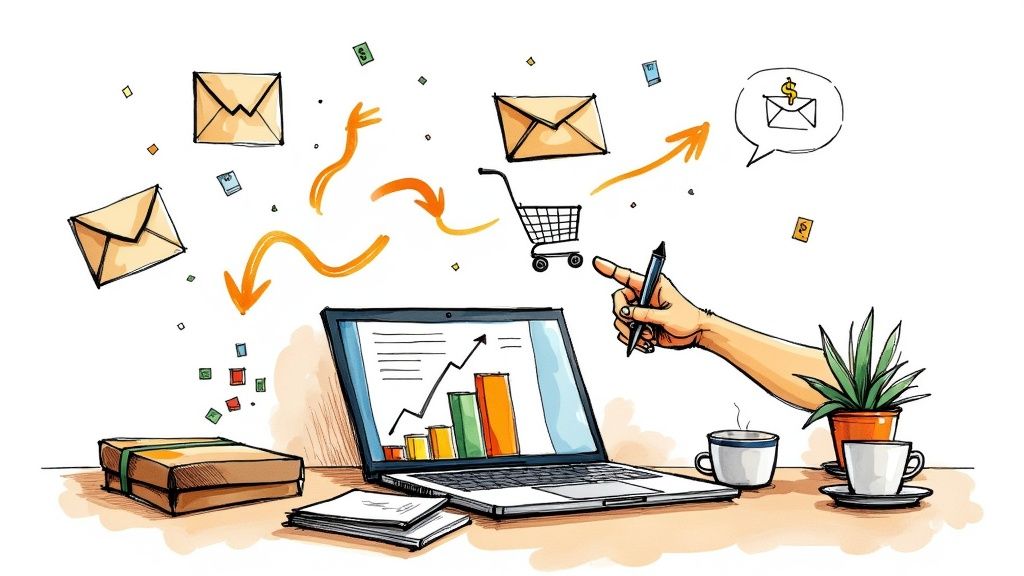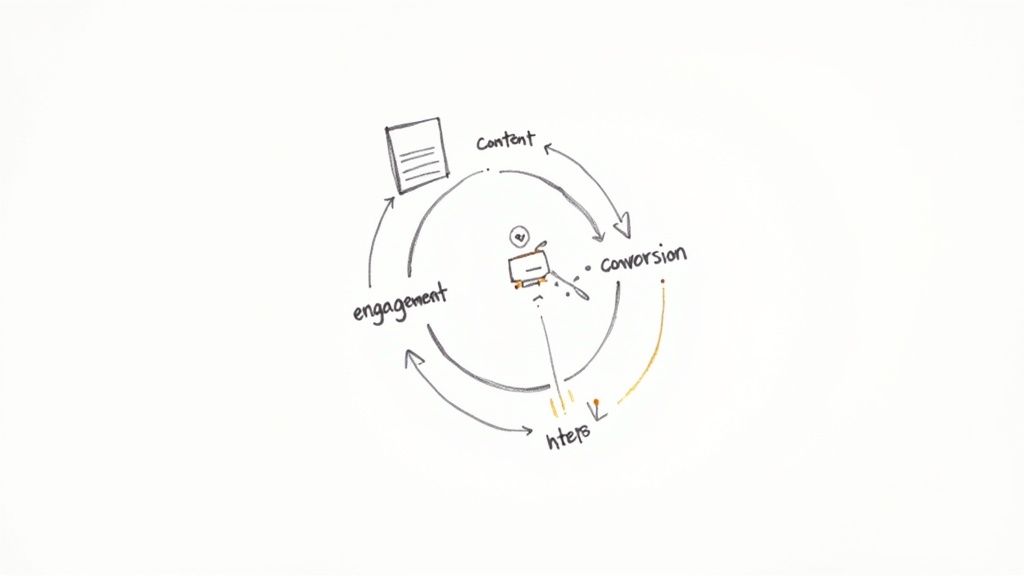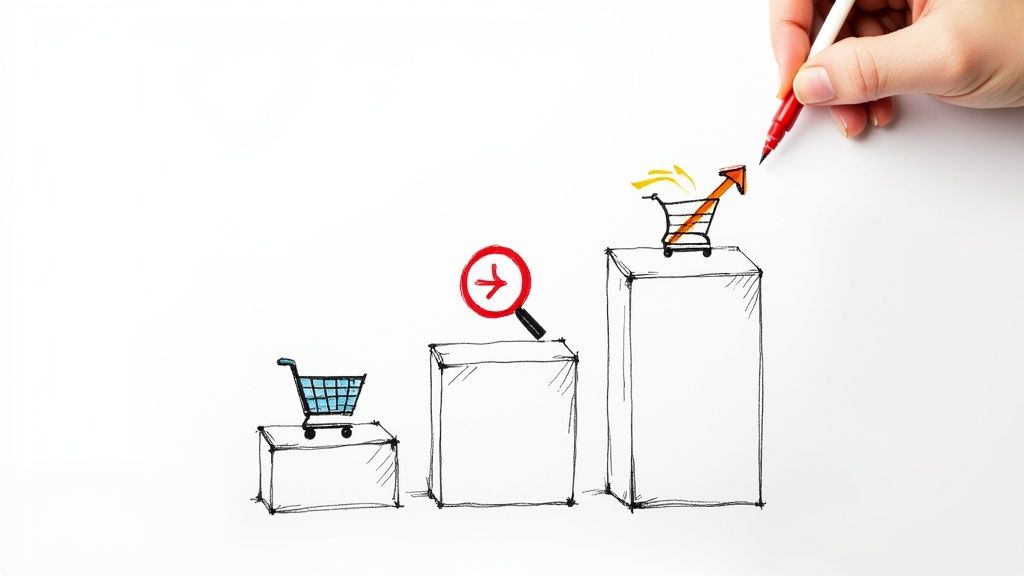Email Marketing Agency Pricing: What You'll Actually Pay
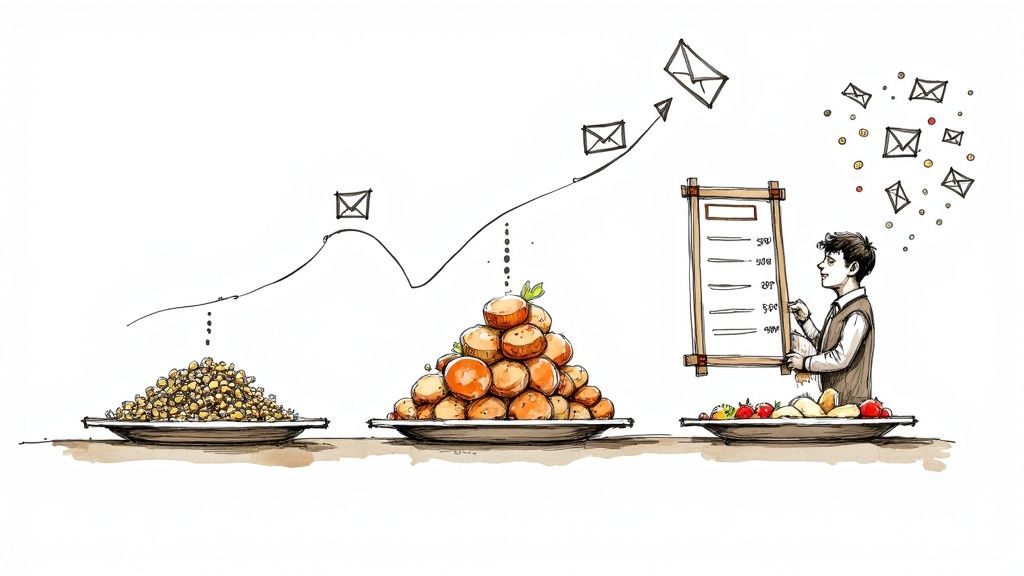
14 mins
6/19/2025
Joe Ervin
- email marketing agency pricing
- email marketing costs
- agency pricing
- digital marketing
- email campaigns
Making Sense of Email Marketing Agency Pricing Models
Imagine walking into a restaurant where some dishes are priced by the ingredient, others are fixed-price meals, and a few are based on how hungry you seem. That’s what exploring email marketing agency pricing can feel like. The good news is these different pricing structures exist for a reason: no two ecommerce brands have the same needs or budget. Understanding them is the first step to finding a partner that truly fits your business.

This variety isn't meant to be confusing; it's designed to provide flexibility. An agency's billing method often reflects its core approach and the type of clients it works with best. Let's look at the most common models you'll come across.
The Four Main Pricing Structures
As you start asking for quotes, you'll find that proposals are almost always built around one of four key models. Each one has its own set of pros and cons and is better suited for certain types of projects.
Monthly Retainer: This is the most popular model for long-term, ongoing work. You pay a set fee each month for a clearly defined scope, like managing a certain number of campaigns and keeping your automated flows running smoothly. This gives you predictable costs and provides the agency with a stable workflow. It’s a great fit for brands aiming for consistent, sustained growth.
Project-Based: This model is perfect for specific, one-off tasks. Need a brand new welcome series built or a complex Black Friday campaign managed from start to finish? Project-based pricing gives you a single, upfront cost for a well-defined outcome. It’s ideal for businesses that aren't ready for a monthly commitment but require expert help on a critical initiative.
Hourly Rate: While less common for complete email management, this is often used for consulting, strategy development, or specific technical fixes. You are billed for the exact amount of time the agency dedicates to your account. Though flexible, it can lead to unpredictable monthly costs if the scope of work isn't carefully managed.
Per-Email Pricing: This structure directly connects your cost to the agency's output. The agency charges a flat rate for every email campaign they design and send. It’s a very direct way to pay for exactly what you get, but it can become costly for brands that send emails frequently.
The actual dollar amounts for these models vary significantly depending on an agency's experience and the services included. General research shows monthly retainers often land between $2,500 and $7,500. Project fees typically start around $1,000 and go up from there. You can expect hourly rates to begin at $120, with per-email charges ranging from $250 to $700. Knowing these models helps you move from being confused by proposals to confidently finding a great partner, not just a cheap one.
What Really Drives Your Email Marketing Investment
Figuring out email marketing agency pricing can feel a lot like buying a house—the price you see online is just the starting point. The final number depends on many factors that aren't always clear from the get-go. While it's easy to assume your subscriber count is the main cost driver, the reality is more complex. A highly engaged list of 10,000 customers can demand more strategic work, and a larger investment, than a passive list of 50,000.

This difference between list size and list quality is important because it shapes how much work an agency needs to do. When you understand what actually affects your bill, you can budget smarter and have more productive conversations with potential partners.
The Core Cost Drivers
Your monthly fee is determined by the depth and intensity of the services you need. Good agencies don't just "send emails"—they build systems designed to generate revenue. These are the main factors that influence the final price.
- List Size and Quality: This is the foundation. A larger list typically means higher costs for the email platform itself and more effort to manage. But agencies also look at your list's health. Cleaning a list full of inactive subscribers or creating segments for a diverse audience takes a lot of initial work, which impacts the cost.
- Campaign Frequency: How many campaigns you send each month is a straightforward cost multiplier. More emails require more hours for copywriting, design, and setup from the agency's team. A brand sending two campaigns a week will have a higher retainer than one sending two a month.
- Service Complexity: This is where pricing can differ the most. A basic package might only cover sending your weekly newsletters. A more involved partnership could include building and fine-tuning sophisticated automated flows, like a detailed welcome series. Developing these automations requires strategic thinking, skilled copywriting, and technical setup. You can learn more about the best practices for an email welcome series to get a sense of what's involved.
To help you visualize how these factors come together, the table below breaks down their impact on your potential monthly costs.
Email Marketing Pricing Factors Comparison
A detailed breakdown of how different factors impact email marketing agency pricing, from list size to service complexity
| Factor | Low Impact | Medium Impact | High Impact | Monthly Cost Range |
|---|---|---|---|---|
| List Size | Under 5,000 subscribers | 5,000 - 25,000 subscribers | 25,000+ subscribers | $500 - $1,500+ |
| Campaign Frequency | 1-2 campaigns/month | 3-4 campaigns/month | 5+ campaigns/month | $750 - $2,500+ |
| Service Complexity | Basic newsletters & reporting | Newsletters + 1-2 simple automations | Advanced segmentation & multiple complex automations | $1,000 - $5,000+ |
| Strategic Input | Minimal strategy, focuses on execution | Monthly strategy calls & performance analysis | Deep partnership with dedicated strategist, A/B testing, and optimization | $1,500 - $7,000+ |
This table shows that while each factor contributes to the cost, the biggest driver is often the complexity of the services. A small list with a need for advanced automation can sometimes cost more than a large list with simple campaign needs.
Advanced Services and Their Price Tag
Beyond the basics, some services carry a premium because they require special skills. Think of it like adding custom features to a new car; each upgrade costs more but seriously improves performance.
- Advanced Segmentation: Splitting your audience based on things like purchase history, browsing behavior, or location enables hyper-personalized messages. This boosts conversion rates but needs a strategist who can find valuable segments and a specialist to implement them in a platform like Klaviyo.
- Behavioral Triggers & Automation: Creating automated emails that trigger from specific customer actions—like viewing a product three times but not buying—is a potent sales tool. These workflows are intricate to design, test, and maintain, which justifies a higher price.
In the end, email marketing agency pricing is a reflection of your list size, the level of service you need, and the agency’s experience. Basic services, including campaign management and reporting, often start between $500 and $1,000 per month. This can grow quickly as you add more complex features for a larger audience. Understanding this helps you see that you're not just paying for emails to be sent, but for a strategic partner focused on growing your business. For a deeper look at how these factors interact, check out this complete guide to email marketing pricing.
Decoding Agency Service Packages and What You Actually Get
Email marketing agencies often structure their offerings like streaming services—a basic tier gets you the essentials, while premium tiers unlock the features that drive serious results. But unlike picking a Netflix plan, choosing the right agency package can dramatically affect your ecommerce brand's bottom line. The key is understanding what you actually get at each level of email marketing agency pricing so you can match your investment to your real needs.
Think of it like building a car. A basic package gives you the engine and wheels to get moving. A premium package adds a turbocharger and better suspension for performance. An enterprise plan is like getting a custom-built race car with a dedicated pit crew. Your goal is to choose the car that fits the race you’re in today, not the one you hope to enter next year.
Breaking Down the Tiers
Most agencies group their services into packages to make buying easier, but the value inside varies wildly. It’s critical to look past the marketing names and focus on the specific deliverables. For instance, some sources indicate that the cost for a single, well-crafted email can range from $200 to over $1,500, depending on its complexity and design. This shows how quickly costs can add up based on what’s included.
Here’s a typical breakdown:
- Basic Packages: These are for brands that need fundamental support. Expect services like weekly newsletter creation, list management, and simple performance reports. This tier is about consistency and execution, not deep strategy. It's a solid starting point if your main goal is to stay in front of your audience regularly.
- Premium Packages: This is where revenue-driving activities begin. You’ll typically get everything in the basic tier plus the creation and management of core automated flows, like abandoned cart reminders and welcome series. Agencies at this level often include more strategic input, A/B testing, and more detailed segmentation to personalize your messaging.
- Enterprise/Custom Packages: Designed for established brands, these packages are all about optimization and growth at scale. Services often include a dedicated strategist, advanced analytics, custom API integrations, and continuous refinement of all email activities. The focus shifts from just running campaigns to building a fully integrated retention marketing system.
To help you see the differences more clearly, the table below compares what you might get at each service level.
Email Marketing Service Package Comparison
Side-by-side comparison of typical basic, premium, and enterprise email marketing agency packages and their features
| Service Feature | Basic Package | Premium Package | Enterprise Package | Typical Add-on Cost |
|---|---|---|---|---|
| Weekly Campaigns | 2-4 per month | 4-8 per month | 8+ per month | $250 - $700+ per campaign |
| Automation Flows | Setup of 1-2 simple flows | Setup & management of 3-5 core flows | Ongoing optimization of all flows | $500 - $1,500+ per flow |
| Segmentation | Basic (e.g., purchasers vs. non-purchasers) | Behavioral & purchase history | Predictive & RFM segmentation | Varies widely |
| Strategy & Reporting | Monthly performance summary | Bi-weekly calls & detailed analysis | Weekly strategy sessions & custom dashboards | $150 - $200+ per hour |
Choosing the right package means honestly assessing your business. A new skincare brand might only need a basic package to build initial momentum. However, a clothing brand with frequent product drops would benefit immensely from the advanced segmentation and automation of a premium package. Mismatching your needs with a package is the fastest way to overpay for services you don’t use or underinvest in the strategies that could actually grow your store.
Agency vs In-House: The Real Math Behind Your Decision
Choosing between an email marketing agency and an in-house team is a major financial fork in the road for any ecommerce brand. Think of it like a home renovation: do you hire a general contractor to manage everything, or do you act as your own project manager, hiring every plumber, electrician, and painter yourself? One path offers coordinated expertise, while the other seems cheaper at first but is filled with hidden costs and headaches.
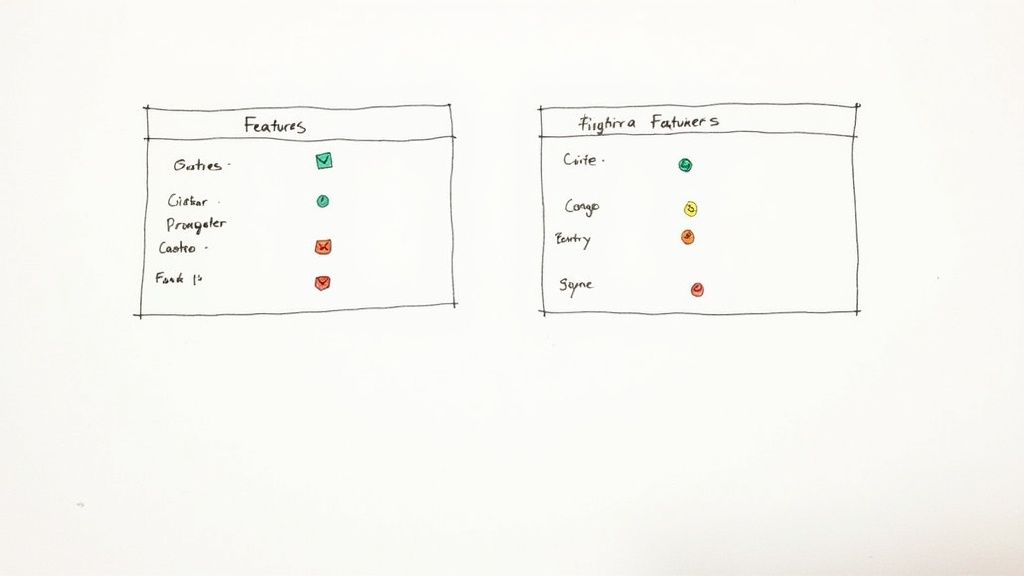
Most brand owners get stuck comparing just two numbers: the agency's monthly fee versus a new hire's salary. This is a common but misleading comparison that completely misses the bigger financial picture. The true cost of building an in-house team extends far beyond that base salary.
The Hidden Costs of an In-House Team
When you hire your own email marketer, their salary is only the starting point. The real cost must include a variety of other expenses that can quickly add up.
- Software Subscriptions: Your team needs more than just a powerful email service provider (ESP) like Klaviyo. You'll also likely need separate tools for graphic design, copywriting help, and project management, all with their own monthly fees.
- Ongoing Training: Email marketing doesn't stand still. Your employee will need constant education on new platform features, deliverability rules, and changing privacy laws. That means you're paying for courses, workshops, and conference tickets.
- The "Mistake Tax": Even a skilled in-house marketer will face a learning curve with your specific brand and audience. Mistakes are inevitable—a broken link in a huge sale announcement or a poorly segmented campaign—and they carry a direct financial cost in lost revenue and customer trust.
- Benefits and Overhead: Don't forget about payroll taxes, health insurance, paid time off, and other benefits. These typically add another 20-30% on top of the employee's base salary.
Comparing the True Investment
Once you stack up all these hidden expenses, the financial logic starts to shift. For many brands, hiring a comprehensive digital marketing agency for ecommerce delivers far more value than a single in-house employee. An agency effectively spreads the cost of an entire team—strategists, copywriters, designers, and technical experts—across its client base. You get access to a full suite of specialists for a price that is often similar to or even less than the fully loaded cost of one senior in-house person.
Studies indicate that managing email marketing in-house can cost a business anywhere from $750 to over $1,000 per month just for software and related costs—and that's before you even pay a salary. While an agency’s price tag might seem higher upfront, the investment often produces a much greater return through specialized knowledge and more effective campaigns. You can find more details in these email advertising cost comparisons to get a clearer financial view. The right choice will depend on your brand's scale, but it's vital to compare the full, true costs of both options, not just the surface-level numbers.
Real Agency Pricing: What Businesses Actually Pay
Pricing models and feature lists are useful, but let's get to the real question: what are ecommerce brands actually paying for email marketing? The answer isn't one-size-fits-all. It changes based on a brand's size, business model, and what they want to achieve.
Let’s look at a couple of real-world scenarios to see how email marketing agency pricing plays out. These aren't just highlight reels; they are practical breakdowns of the investment required and the services you get for it.
Case Study 1: The Bootstrapped Skincare Brand
Picture a direct-to-consumer skincare brand with a small but dedicated following. They have an email list of around 5,000 customers and are just beginning to see the power of email. Their main goal is simple: nurture new leads and encourage repeat buys without breaking the bank.
- Investment: $3,500 monthly retainer.
- What They Get: This budget typically secures a premium package from a smaller, specialized agency. Services often include managing two promotional campaigns each week and setting up three core automation flows: a welcome series, an abandoned cart sequence, and a post-purchase follow-up. The brand also gets monthly strategy calls and performance reports.
- The Focus: The work is all about building a solid foundation. The agency concentrates on creating high-quality, reusable email templates and perfecting the essential automations that generate revenue automatically. While complex segmentation isn't the priority yet, the objective is to establish a dependable income stream from their email list. You can learn more about what's involved by checking out our guide on ecommerce email flows.
Case Study 2: The Established Ecommerce Retailer
Now, think about a well-known clothing brand with a list of 100,000 customers. Their business is more complex, juggling seasonal product launches, frequent sales, and the need to keep customers loyal while preventing churn.
- Investment: $8,000+ monthly retainer.
- What They Get: An investment at this level buys a custom, enterprise-grade service. The agency becomes a true strategic partner, managing a packed calendar with 4-5 campaigns per week. More importantly, they oversee a dozen intricate, multi-step automation flows triggered by customer actions, like browsing history or purchase frequency. This service includes a dedicated strategist, advanced segmentation based on customer lifetime value, A/B testing for all campaigns, and custom-designed emails for every single send.
- The Focus: Here, the goal is all about optimization and growth. The agency isn't just sending emails; they're constructing a detailed retention marketing machine. The aim is to maximize the value of each customer across a large and varied audience.
It's also crucial to remember that agency fees are separate from the software costs. For instance, here's a glance at the public pricing for a popular platform, Mailchimp, which scales up as your contact list grows.
This shows that the tool alone can cost anywhere from a modest monthly fee to thousands of dollars. That's an expense you'll have whether you hire an agency or manage email in-house. As these examples illustrate, the agency's fee covers the human expertise, strategic thinking, and creative work needed to get a real return on that software investment.
Smart Strategies for Managing Your Email Marketing Budget
Budgeting for an email marketing agency isn't just about finding the lowest price—it's about making a smart investment that grows with your business. The right partnership should feel like a performance engine, not just another line item on your expense report. By thinking strategically about how you negotiate and manage your contract, you can secure better rates and protect your brand from surprise costs later on.
Thinking a few steps ahead can save you thousands. For example, timing can make a huge difference. Agencies, like any business, have slower seasons or end-of-quarter pushes to meet revenue targets. Approaching them during these periods with a clear scope of work can give you some serious negotiating power.
Structuring a Flexible and Fair Agreement
Your contract is your most important tool for keeping costs in check. Instead of getting stuck in a rigid, long-term deal, aim for flexibility that mirrors the natural ups and downs of an ecommerce business.
Here are a few smart terms to include in your agreement:
- Performance-Based Incentives: Suggest a model with a reasonable base retainer plus a bonus tied to specific results, like revenue generated directly from email campaigns. This aligns the agency’s goals with yours, making sure they’re focused on delivering a real financial impact.
- Seasonal Scalability Clauses: If your sales spike during certain times of the year, your contract should reflect that. Negotiate the ability to scale services up for big events like Black Friday and then dial them back during quieter months without facing penalties. This stops you from paying for services you don't need all year round.
- Clear Renewal and Transition Terms: Watch out for automatic renewal clauses that can lock you into another long-term commitment without a proper review. Instead, ask for a 90-day review period before the contract ends. This gives you plenty of time to evaluate their performance and, if needed, find a new agency without paying for overlapping services.
Scaling Your Investment Without Breaking the Bank
As your email list grows, your agency costs will naturally go up. The trick is to make sure your pricing scales fairly. A pricing model that works when you have 1,000 subscribers can become painfully expensive once you hit 50,000. It's wise to discuss tiered pricing upfront that clearly defines costs at different subscriber levels (e.g., 25k, 50k, 100k).
This proactive approach to managing your email marketing agency pricing changes the dynamic from a simple transaction to a genuine partnership. When you build an agreement that adapts to your business's needs, you create a solid foundation for profitable, long-term growth.
Making Your Final Agency Investment Decision
Choosing the right agency is a major step that will influence your brand's trajectory for months, if not years. To make the right call, you need to look past the price tags on proposals and focus on the actual value an agency can bring to your business. This means asking smart questions that reveal whether a potential partner truly gets your brand and its specific hurdles.
The best partnerships are built on a foundation of clarity and shared goals. A great agency doesn't just check off tasks; they act as a strategic ally who is genuinely invested in your success. When you're sifting through proposals for email marketing agency pricing, your mission is to find the team that offers the best potential return, not just the lowest monthly bill.
Questions That Reveal True Value
Before you put pen to paper on any contract, make sure you get solid answers to these crucial questions. How they respond will tell you almost everything you need to know about their skills and strategic mindset.
- "Based on our business model, what specific automations do you believe will drive the most revenue in the first 90 days?" This question cuts right to the chase, testing their strategic thinking and whether they have a ready-to-go plan for making an immediate impact.
- "Can you show us a case study of a brand similar to ours? What were the key challenges, and how did your strategy overcome them?" This forces them to move beyond generic success stories and prove they have relevant, hands-on experience.
- "How will you measure success beyond open rates and clicks? What is your process for reporting on revenue attribution?" This confirms they're focused on the one metric that truly matters to your bottom line: sales.
Calculating ROI and Setting Expectations
To make a truly informed decision, you have to run the numbers and calculate the potential return on your investment. First, define what success looks like. If an agency's retainer is $4,000 per month and your average order value (AOV) is $80, they need to generate at least 50 extra sales every single month just to cover their cost.
A solid agency should be aiming to deliver a 3x to 5x return on their fee over time. Setting these realistic expectations from day one creates accountability. Your contract should include regular performance reviews directly tied to these financial targets. This simple step shifts your agency from being a business expense to becoming a powerful growth engine, ensuring you get exactly what you're paying for.
